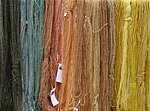Portal:Clothing/Selected article/21
Natural dyes are dyes or colorants derived from plants, insects, or minerals. The majority of natural dyes are vegetable dyes from plant sources – roots, berries, bark, leaves, and wood — and other natural sources such as fungi and lichens.
Archaeologists have found evidence of textile dyeing dating back to the Neolithic period. In China, dyeing with plants, barks and insects has been traced back more than 5,000 years.[1] Natural insect dyes such as Tyrian purple and kermes and plant-based dyes such as woad, indigo and madder were important elements of the economies of Asia and Europe until the discovery of man-made synthetic dyes in the mid-19th century. Synthetic dyes quickly superseded natural dyes for the large-scale commercial textile production enabled by the Industrial Revolution, but remained in use by traditional cultures around the world.
Artists of the Arts and Crafts movement preferred the pure shades and subtle variability of natural dyes, which mellow with age but preserve their true colors, unlike early synthetic dyes,[1] and helped ensure that the old European techniques for dyeing and printing with natural dyestuffs were preserved for use by home and craft dyers.

